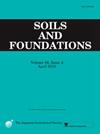Strength development of dredged sediment stabilized with nano-modified sulphoaluminate cement
IF 3.3
2区 工程技术
Q2 ENGINEERING, GEOLOGICAL
引用次数: 0
Abstract
Sulphoaluminate cement (SAC) is considered a low-carbon and energy-saving cementitious material, compared with ordinary Portland cement. However, the stabilization efficiency and improvement measures of SAC for dredged sediment (DS) are still unclear. This study used SAC as stabilizer for DS with high water content, and nanoparticles including nano-SiO2 (NS), nano-MgO (NM) and nano-Al2O3 (NA) were incorporated as nano-modifiers. Unconfined compressive strength (UCS) tests were carried out to evaluate the strength development of SAC-stabilized DS (SDS) and nano-modified SDS considering multiple influencing factors. Furthermore, the micro-mechanisms characterizing the strength development of SDS and nano-modified SDS were clarified and discussed based on X-ray diffraction (XRD) and scanning electron microscopy (SEM) tests. The results present that increasing SAC content or decreasing water content can obviously enhance the strength gaining of SDS, while the strength reduction also occurred. Incorporating suitable nanoparticles could significantly improve the strength gaining and simultaneously avoid the strength reduction of SDS. The optimum content of single NS, NM and NA was respectively 4 %, 6 % and 6 %. Composite nanoparticles containing two types of nanoparticles also exhibit positive effect on the strength gaining of SDS, and the optimum mass ratios of NS-NM, NS-NA and NM-NA were respectively 3:7, 1:9 and 5:5. By comparison, adding 6 % NA to SDS achieved the highest strength gaining. The hydration product ettringite was mainly responsible for the strength development of SDS and nano-modified SDS, and incorporating nanoparticles especially NA contributed to the formation of a tighter structure with stronger cementation inside nano-modified SDS. A conceptual model was proposed to characterize the micro-mechanism of strength development in nano-modified SDS.
纳米改性硫铝酸盐水泥稳定疏浚泥沙的强度发展
与普通硅酸盐水泥相比,硫铝酸盐水泥(SAC)被认为是一种低碳、节能的胶凝材料。然而,SAC对疏浚泥沙的稳定效果和改进措施尚不清楚。本研究采用SAC作为高含水量DS的稳定剂,并采用纳米sio2 (NS)、纳米mgo (NM)和纳米al2o3 (NA)作为纳米改性剂。通过无侧限抗压强度(UCS)试验,对多种影响因素下sac稳定SDS (SDS)和纳米改性SDS的强度发展进行了评价。此外,通过x射线衍射(XRD)和扫描电镜(SEM)测试,阐明并讨论了SDS和纳米改性SDS强度发展的微观机理。结果表明,增加SAC含量或降低含水量均能明显提高SDS的强度增益,但也会出现强度降低。加入合适的纳米颗粒可以显著提高SDS的强度增益,同时避免SDS的强度降低。单粒氮素、纳米粒和NA的最佳含量分别为4%、6%和6%。含有两种纳米颗粒的复合纳米颗粒对SDS的强度获得也有积极的影响,其中NS-NM、NS-NA和NM-NA的最佳质量比分别为3:7、1:9和5:5。通过比较,SDS中添加6% NA的强度增益最高。水化产物钙矾石对SDS和纳米改性SDS的强度发展起主要作用,纳米颗粒尤其是NA的掺入有助于SDS内部形成更紧密的结构和更强的胶结作用。提出了表征纳米改性SDS强度发展微观机制的概念模型。
本文章由计算机程序翻译,如有差异,请以英文原文为准。
求助全文
约1分钟内获得全文
求助全文
来源期刊

Soils and Foundations
工程技术-地球科学综合
CiteScore
6.40
自引率
8.10%
发文量
99
审稿时长
5 months
期刊介绍:
Soils and Foundations is one of the leading journals in the field of soil mechanics and geotechnical engineering. It is the official journal of the Japanese Geotechnical Society (JGS)., The journal publishes a variety of original research paper, technical reports, technical notes, as well as the state-of-the-art reports upon invitation by the Editor, in the fields of soil and rock mechanics, geotechnical engineering, and environmental geotechnics. Since the publication of Volume 1, No.1 issue in June 1960, Soils and Foundations will celebrate the 60th anniversary in the year of 2020.
Soils and Foundations welcomes theoretical as well as practical work associated with the aforementioned field(s). Case studies that describe the original and interdisciplinary work applicable to geotechnical engineering are particularly encouraged. Discussions to each of the published articles are also welcomed in order to provide an avenue in which opinions of peers may be fed back or exchanged. In providing latest expertise on a specific topic, one issue out of six per year on average was allocated to include selected papers from the International Symposia which were held in Japan as well as overseas.
 求助内容:
求助内容: 应助结果提醒方式:
应助结果提醒方式:


